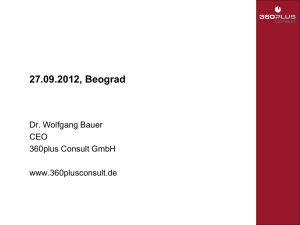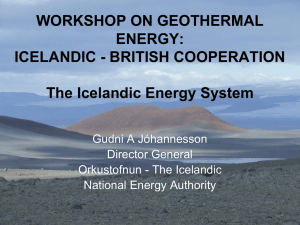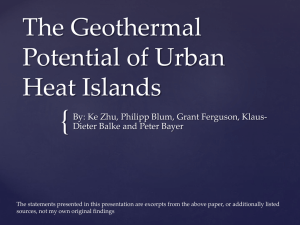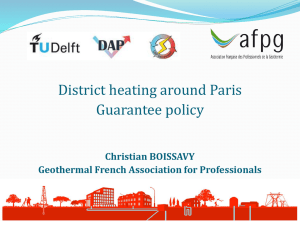DOCX 6MB - Australian Renewable Energy Agency
advertisement
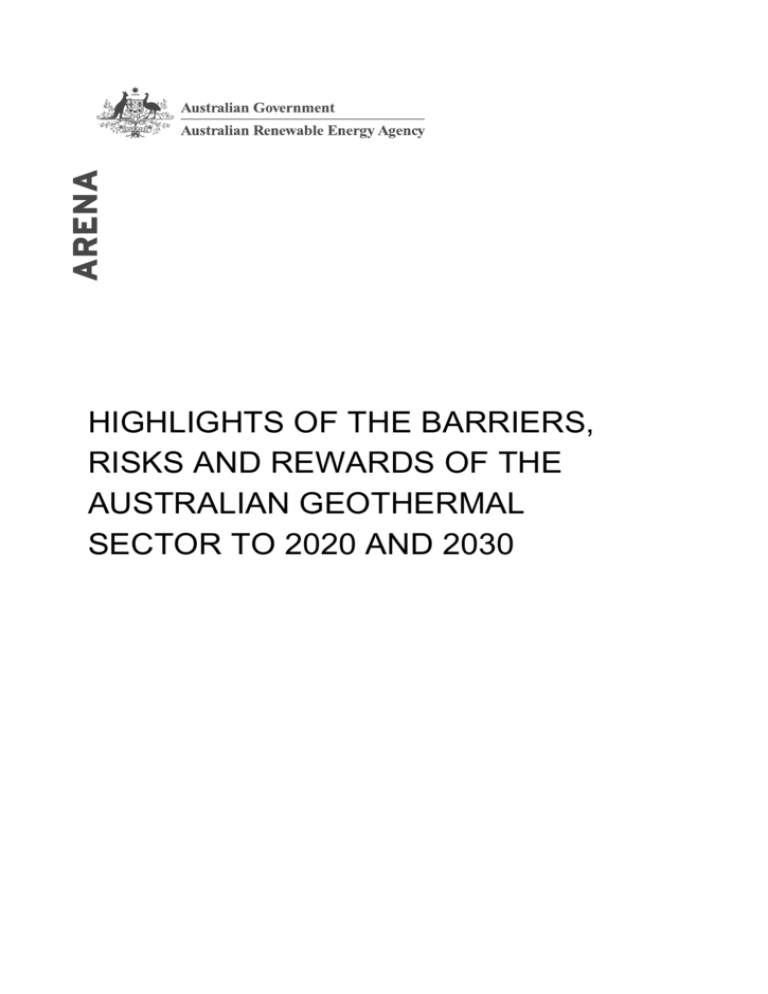
HIGHLIGHTS OF THE BARRIERS, RISKS AND REWARDS OF THE AUSTRALIAN GEOTHERMAL SECTOR TO 2020 AND 2030 Australian Renewable Energy Agency NewActon Nishi 2 Phillip Law Street Canberra ACT 2601 GPO Box 643 Canberra ACT 2601 Phone: +61 2 6243 7773 Fax +61 2 6243 7037 Email: arena@arena.gov.au Contact person for this report: Damir Ivkovic Strategic Knowledge and Communication, ARENA Content: Australian Renewable Energy Agency Coordination, editing and indexing: Australian Renewable Energy Agency Design: Giraffe VCM Printing: CanPrint Communications (printed publication) : 978-0-9925510-3-2 (PDF online format) : 978-0-9925510-4-9 (Word online format) : 978-0-9925510-5-6 This work is copyright, the copyright being owned by the Commonwealth of Australia. With the exception of the Commonwealth Coat of Arms, the logo of ARENA and other third-party material which is protected by intellectual property law, this copyright work is licensed under the Creative Commons Attribution 3.0 Australia Licence. Under this licence, you are free to copy, communicate and adapt the work, so long as you attribute the work to the Commonwealth of Australia (Australian Renewable Energy Agency) and abide by the other licence terms. This work should be attributed in the following way: © Commonwealth of Australia (Australian Renewable Energy Agency) 2014 Requests and enquiries concerning reproduction and rights should be addressed to arena@arena.gov.au. 1. INTRODUCTION In 2013 the Australian Renewable Energy Agency (ARENA) sought advice on the barriers to, and opportunities for, the commercial deployment of geothermal energy in Australia. ARENA formed the International Geothermal Expert Group (IGEG), supported by key staff at CSIRO, to provide this advice. In a full report to the ARENA Board, the IGEG critically evaluated the potential commercial viability of utility-scale geothermal energy in Australia in 2020 and 2030, without long-term subsidy. This document presents the highlights from the full report including: a description of geothermal energy a short history of geothermal energy the strengths, weaknesses, opportunities and threats facing geothermal energy in Australia the risks and rewards of geothermal energy in Australia, and the IGEG’s key findings. 2. WHAT IS GEOTHERMAL ENERGY? Geothermal energy is heat from the earth. Economic and beneficial use of this heat is achieved by bringing the heat to the surface in a fluid (steam or water), where it can be used directly for heating, drying, in chillers or for electricity generation. Geothermal resources come in two broad categories, convective and conductive resources. In a convection-dominated geothermal resource, the heat is moved through the earth by the movement of water or steam. Most of the geothermal projects operating in the world today use convective geothermal resources. These resources are typically high temperature and associated with volcanic activity and/or tectonic plate boundaries. Examples include the Wairakei Geothermal Power Plant in New Zealand, the Geysers Power Plant in the USA and several combined power and district heating projects in Iceland. In a conduction-dominated geothermal resource, heat flows through the earth without any movement of material or fluid. These resources tend to have lower temperatures or greater depths than convective geothermal resources. Although these resources are potentially more extensive, they have not been developed as much as convective geothermal resources but are receiving increasing attention globally. Examples include the Soultz Geothermal Power Station in France, several combined power/district heating projects in the Molasse Basin in Germany and Australia’s geothermal resources. The figure to the right shows a simplified geothermal resource in a conductive geothermal setting. The main components of this geothermal system are the geothermal resource (which contains the heat energy), the two wells, which are used to access this heat, and the power plant at the surface where the heat is used to generate electricity. Geothermal heat is brought to the surface in water that is pumped down one of the wells, through fractures in the reservoir, and then back to the surface in the second well. These fractures can be natural or may be enhanced or created through stimulation of the reservoir by injecting water at high pressure. Heat is transferred from the hot water that has been pumped to the surface to a working fluid for the power station through a heat exchanger. The hot working fluid then passes through a turbine, which drives the generator, producing electricity. These three components – the geothermal resource (the heat), the access to the resource (wells), and the heat utilisation system (power plant or direct use of heat) are common to all geothermal systems. A schematic representation of a geothermal power plant in a conductive geothermal setting. (Source: CSIRO) Convective or conventional geothermal energy resource. Hellisheiði Power Station, Iceland. (Photo: Wikimedia Commons) Wairakei Power Station, New Zealand. Built in 1958, it was the first of its type (using wet steam) in the world. (Photo: Wikipedia) Conductive or unconventional geothermal resource in Germany. Landau production and injection well with plant building in background. (Photo: S. Petty) A compilation of Australian geothermal resources as reported by companies exploring for geothermal resources, and documented in the 2014 Australian Energy Resource Assessment found that, in energy terms, Australia possessed geothermal resources equivalent to approximately 16 billion tonnes of black coal. Australian geothermal resources include: a. Shallow Direct-use resources, typically in the 500 m to 1,500 m depth range that target aquifers with low to moderate temperatures, primarily for direct-use applications b. Deep Natural Reservoir resources that are typically greater than 1,500 m deep and target sedimentary or naturally fractured aquifers for direct-heat use or electricity generation c. Enhanced Geothermal Systems (EGS) resources, where the underground reservoir has to be ‘stimulated’ before it can deliver commercially viable energy for either direct use or electricity generation. 3. HISTORY OF GEOTHERMAL ENERGY Worldwide geothermal generation capacity has expanded steadily since the 1970s. There is now over 10,000 megawatts of installed generating capacity worldwide, producing more than 67,000 GWh of electricity per year (that equates to about one quarter of Australia’s total annual electricty production). The USA, the Phillipines, Indonesia, Mexico, Italy, Iceland, Japan and New Zealand account for most of this production. Direct uses of geothermal energy are widespread globally and include district heating schemes, agricultural and industrial applications, and the heating of pools and spas. Globally, over 120,000 GWh of energy is used in direct heat applications every year with a high growth rate. World Geothermal Electricity 20'000 80'000 70'000 60'000 MW 50'000 10'000 40'000 GWh 15'000 30'000 5'000 20'000 10'000 0 1950 1960 1970 Installed Capacity (MW) 1980 1990 Years Projected Capacity 2000 2010 0 2020 Produced Energy (GWh) World geothermal electricity, installed capacity (MW) and produced electricity (GWh), 1950–2010, from Bertani (2010). Before the mid-1990s, geothermal energy activity in Australia was focused on direct-use applications of hot groundwater. The Birdsville geothermal power plant, in south-west Queensland, is Australia’s only operating geothermal power plant. It was built as an experimental plant and was funded by state and federal governments. This plant currently supplies about one third of the town’s electricity needs. In Australia, the first geothermal exploration lease was granted in NSW in 1999. By 2004, there were 24 geothermal exploration leases in South Australia and two in New South Wales. The peak of activity came in 2010, with 414 exploration licences or licence applications covering almost a half million square kilometres all across Australia. Total expenditure on geothermal energy developments and research in Australia since the late 1990s is approximately $900 million (in nominal dollars), or over $1 billion in 2014 dollars. The Birdsville geothermal power station is owned and operated by Ergon Energy and draws on a 1.28 km deep free-flowing bore into the Great Artesian Basin. (Photo: C. Huddlestone-Holmes) Convective or Enhanced Geothermal System in South Australia. Geodynamics’ Innamincka Deeps Project power plant. (Photo: Geodynamics Ltd) Many Australian examples exist of direct-use geothermal applications. For instance, the hot artesian waters in the Great Artesian Basin are used for therapeutic baths, there are two fish farms that use warm groundwater for aquaculture in Victoria and South Australia, and a meat processing plant in Victoria uses warm groundwater for feedwater for sterilization and hand washing. Perth has 11 commercial direct-use geothermal projects that use geothermal fluid from the Yarragadee Aquifer to heat swimming pools. Following a drilling program, co-funded by Australian governments and investors, a pilot electricity generation plant powered by conductive geothermal energy ran from April to October 2013 at Innamincka in the Cooper Basin, South Australia. 4. STRENGTHS, WEAKNESS, OPPORTUNITIES AND THREATS A strengths, weaknesses, opportunities and threats (SWOT) analysis of the Australian geothermal sector is colour-coded according to four themes: 1. Policy, social and community issues, jobs and employment 2. Markets, finance and electric system operation 3. Technology and engineering 4. Environmental issues and externalities. Positive Attributes Negative Attributes Internal Factors, Current Traits Strengths Weaknesses 1. Public support for a made-in-Australia energy source 1. Small sector with limited capacity (manpower) 2. Emerging direct-use sector 2. 3. Experienced and skilled professionals in government agencies, industry, service companies and research organisations Policy inconsistency within the geothermal sector 3. Reliance on petroleum sector for services and labour 4. Unfavourable perception of the returns in the geothermal sector by the finance/investment sector 5. Upfront costs of project development are very high 6. Immature established workflow or exploration tools to de-risk projects prior to drilling 7. Limited track record for geothermal projects in Australian grid 8. Small sector with limited capital 9. Large uncertainty around necessary resource characteristics for commercial viability 4. Large potential energy source with positive attributes (e.g., dispatchable, base-load power) 5. Well-developed and established national mining and resources sector that can complement/support geothermal sector 6. Industryx underpinned by existing technology 7. Proof of concept for EGS demonstrated at Innamincka 8. Industry has baseline understanding of Australia’s geothermal resources 10. Technologies for exploiting the resource are not mature in enhanced geothermal systems 11. Lack of understanding of the distribution of geothermal resources and their characteristics 9. Carbon neutral 12. Water use 13. Microseismicity potential External Environment; Future Scenarios 14. Distance of transmission connection to grid for some geothermal resources Opportunities Threats 1. Public demand for low emissions dispatchable power 1. Social licence to operate may be threatened by hydraulic fracturing 2. Development of policy drivers to accelerate reduction of fossil fuel use, nationally and globally 2. Falling demand on National Electricity Market 3. 3. Creation of new direct-use market, especially gas sector Potential loss of established skills and knowledge 4. Opportunity for new off grid market 5. Market drivers that create a favourable environment for geothermal energy development 6. Technical breakthroughs reduce the costs of the energy produced from geothermal projects and lower the risks in their development 4. Uncertain market conditions (national energy policy) 5. Market conditions set return on investment at level that is too low to attract investment given the perceived risks in geothermal projects 6. Market perception is that the technology is high risk Positive Attributes Negative Attributes 7. Share resources and knowledge with petroleum sector to mutual advantage 7. Market competition for service providers driving costs up in the short term 8. Create load/dispatchable power source 8. Technical challenges cannot be solved 9. Unconventional gas developments may reduce drilling costs over time 9. Other technologies crowd out geothermal energy 10. Create and capture GHG credits 11. Collaborate on carbon-storage mechanisms 10. Deferral of investments in environmentally benign technologies SWOT of the Australian Geothermal Energy Sector, 2014. 5. COMMERCIAL READINESS INDEX Successful geothermal projects and systems depend on a combination of adequate resource potential (temperature and flow rates at depths) and market. To compare funding opportunities, ARENA developed the Commercial Readiness Index (CRI) to consider all aspects of a technology’s readiness, including the maturity of the technology, costs, market and the supporting framework. Underlying the CRI is an additional tool known as the Technology Readiness Level (TRL) index. This is a globally accepted benchmarking tool for tracking progress and supporting the development of a specific technology through the early stages of the innovation chain from ideas and inventions to actual system demonstration. The relationship between the CRIs and TRLs. (Australian Renewable Energy Agency) Using a CRI, the three types of geothermal resources can be compared in terms of their readiness for commercial deployment. The technology for Shallow Direct-use resources is well advanced, as demonstrated by the projects established in Perth and Victoria: costs are well known and the resource is well understood. Shows overall status STATUS SUMMARY ‘Bankable’ Grade asset class 6 Market compe on driving Widespread Deployment 5 Mul ple commercial ons 4 Commercial scale-up 3 Commercial trial 2 Hypothe cal commercial on pr 1 Company maturity Pathways to market Industry supply chain and skills Financial Pr on - revenue Financial pr on - costs Shows the key barrier Technical performance Regulatory environment Band indicates status varies according on Stakeholder acceptance INDICATORS Commercial readiness index for Shallow Direct-use geothermal resource. By comparison, the commercial readiness levels for EGS and Deep Natural Reservoir resources are much lower because technology developments are in their infancy in Australia and there are substantial resource risks. STATUS SUMMARY ‘Bankable’ Grade asset class 6 Market compe on driving widespread deployment 5 Mul ple commercial ons 4 Commercial scale-up 3 Commercial trial 2 Hypothe cal commercial pr on 1 Commercial readiness index for Deep Natural Reservoir geothermal resource. Company maturity Pathways to market Industry supply chain and skills Financial on pPr - revenue Financial pr on - costs Technical performance Stakeholder acceptance Regulatory environment INDICATORS STATUS SUMMARY ‘Bankable’ Grade asset class 6 Market compe on driving widespread deployment 5 Mul ple commercial ons 4 Commercial scale-up 3 Commercial trial 2 Hypothe cal commercial pr on 1 Company maturity Pathways to market Industry supply chain and skills Financial on pPr - revenue Financial pr on - costs Technical performance Stakeholder acceptance Regulatory environment INDICATORS Commercial readiness index for Enhanced Geothermal System geothermal resource. 6. RISKS AND REWARDS The cost competitiveness of geothermal energy in the electricity generation sector is determined by its own costs as well as the costs of competing technologies. There are many risks that affect the cost of electricity generation and cost competitiveness. In the case of geothermal energy, not only is there a cost in developing the resource and bringing it to market, but there is also a substantial cost and risk in finding a suitable resource. The rewards for delivering cost-competitive electricity are the returns from the sale of electricity either within the grid or off grid. Typically, off-grid prices are much higher, due to higher costs of electricity generation in remote or inaccessible locations. High 100% Cost 50% Moderate Cumulativ Cos t Project Risk e B Risk 0% Operatio & Maintenance Start-Upn Constructio Drillingn A Feasibility Study Planning Test Drilling n Exploratio Pre-Survey Low Project costs and risk profile through the development of a geothermal resource. (Adapted from Gehringer & Loksha, 2012) The figure above shows the evolution of risk and cost in the life cycle of a geothermal project. Geothermal drilling activities currently find themselves in the higher risk profile zone (labelled B in the figure). There is a high degree of risk in the early exploration stages up to Point A and, in fact, many projects do not proceed beyond this point, despite considerable expenditure. This is similar to the exploration risks faced in developing many sub-surface resources, such as oil and gas. The combined costs across stages of a geothermal power project determine its cost competitiveness. A method exists to compare costs across all types of technologies and is known as the levelised cost of energy (or electricity) or LCOE. The LCOE for geothermal energy is sensitive to changes in the key cost parameters associated with the following variables: 1. drilling costs which depend on the depth of the production wells 2. the costs of stimulating the resource to generate flow in enhanced geothermal systems 3. temperature of the reservoir or resource 4. the flow rate or rate at which the water or steam flows through the system. The figure right shows the LCOE for a range of generating technologies in 2020. Geothermal energy has an estimated base LCOE in 2020 of about $200/MWh, with a wide range that reflects the uncertainty in the input parameters used to derive these costs. Whether geothermal energy can be cost competitive with alternative technologies depends on the LCOE of alternatives, such as wind and solar photovoltaics. The figures right illustrate the relative cost of geothermal energy to alternatives in 2020 and 2030. In 2020 geothermal energy is unlikely to be cost competitive with existing fossil-fuel-sourced electricity generation or renewables. In 2030, geothermal energy may become cost competitive with some fossil-fuel technologies, but only in a most favourable scenario for the geothermal sector and with a carbon price. For this scenario to arise there would need to be research and development support in Australia to improve the technologies to find prospective geothermal resources (without drilling) and methods to enhance the flow from reservoirs. Even in this most favourable scenario, for 2030 it is likely geothermal energy would still cost more to produce than some renewables, such as wind power generation. 300 250 LCOE ($/MWh) 200 150 100 50 0 Brown Coal Black Coal Gas Solar Wind Geothermal 2020 costs (light brown, no carbon price, dark brown, carbon price). Data for geothermal energy from this study. Other data from Australian Energy Market Analysis for IGEG, CSIRO. 250 LCOE ($/MWh) 200 150 100 50 0 Brown Coal Black Coal Gas Brown Coal CCS Black Coal CCS Gas CCS Solar Wind Geothermal 2030 costs (light brown, no carbon price, dark brown, carbon price). Data for geothermal energy this study. Other data from Australian Energy Market Analysis for IGEG, CSIRO. At a large-scale commercial level, there are no direct-use projects currently operational in Australia. Nevertheless, there are many possible applications in energy intensive sectors, such as mining and resource processing. One of the most prospective direct-heat applications is in the oil and gas sector, where an identified geothermal resource is co-located with processing and recovery facilities. This is because natural gas requires processing to remove impurities when it is extracted, prior to transportation to market through gas pipelines and geothermal direct heat may provide a cost competitive energy source for this purpose. Moomba gas processing plant, Cooper Basin. (Photo: Primary Industries and Regions SA) Much higher future gas prices, which are projected over the next decade with the advent of gas exports from Eastern Australia, would likely stimulate gas production from conventional gas wells and from shale gas. In this scenario, coupled with gas production from relatively high-cost shale gas, geothermal energy could become cost competitive with gas in terms of providing the energy source to meet the parasitic load for gas processing. In the Cooper Basin, where much of the current exploration of shale gas is occurring, the gas price at the processing facilities at Moomba, the cost of gas extraction, and the cost (high-flow scenario) of direct-heat geothermal energy generation suggest that geothermal could become cost competitive for gas processing by the 2020s. Comparison of geothermal heat production cost with gas production price and gas selling price. 7. KEY FINDINGS 1. Australia has a large geothermal potential with widely distributed resources that could be used for direct heat or to generate electricity in the future. 2. The Australian geothermal sector has received funding from private investors and governments that has totalled nearly $1 billion since the 1990s. 3. Exploration efforts in the geothermal sector peaked in 2010, with 414 applications for exploration licences – or an 83-fold increase from only five applications in 2002. 4. The sector’s principal strength, for utility-scale power generation, is that it is a dispatchable base-load power source with low environmental footprint, while its major weaknesses in Australia are that it has immature technological and commercial readiness and has both uncertain and relatively high development costs. Its greatest opportunities are in new and off-grid markets, and its primary threats are low demand growth for electricity and continued lower costs of alternative renewable energy sources. 5. The major technical barriers to further development in the Australian geothermal sector are the need for precompetitive data and methods to increase the likelihood of drilling successful geothermal wells in a prospective resource, and the methods to enhance the flow rate from reservoirs. 6. The major risks to investors in the Australian geothermal sector are the high upfront costs in proving a resource relative to the returns from direct-heat use or electricity generation. Ultimately, for commercial grade projects, the costs of drilling are the largest contributor to the overall capital costs of geothermal energy generation. The costs of drilling in Australia are very high by comparison to costs in the USA. 7. Utility-scale power generation from geothermal projects is not cost competitive in 2014, and is not expected to be cost competitive in 2020. Utility-scale power generation from geothermal projects may become cost competitive with fossil fuel dispatchable power generation by 2030, but only with a high carbon price and in a ‘least cost’ or most favourable scenario for geothermal energy. 8. The most prospective markets for geothermal energy in Australia out to 2030 are in remote locations that are off the grid, and where there are commercial-scale applications for either electricity or direct heat.



